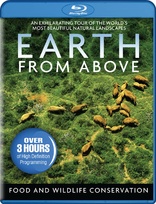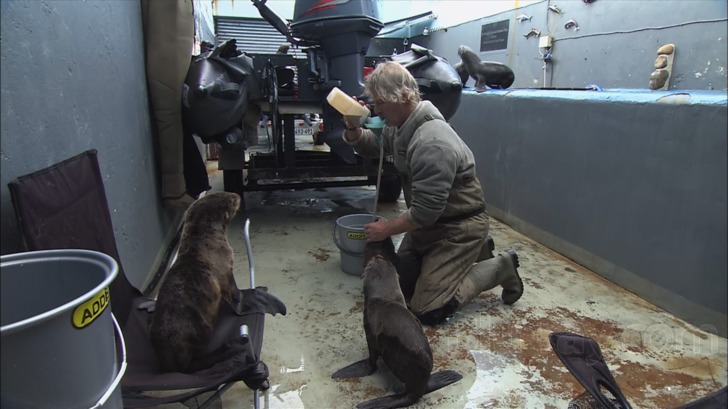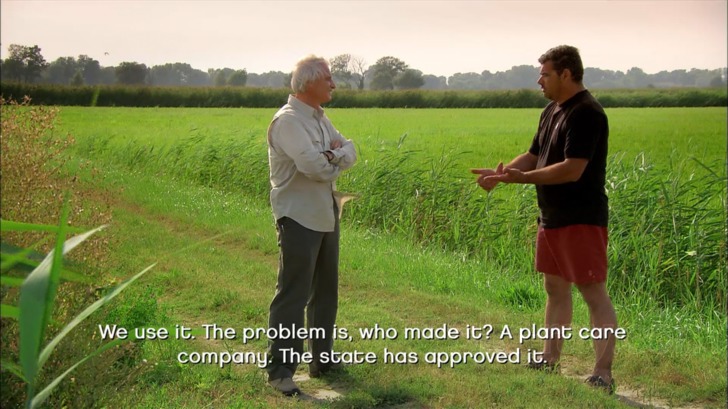Earth From Above: Food and Wildlife Conservation Blu-ray Movie
HomeEarth From Above: Food and Wildlife Conservation Blu-ray Movie 
Mill Creek Entertainment | 2004 | 198 min | Rated G | Jun 26, 2012
Movie rating
6.1 | / 10 |
Blu-ray rating
| Users | 0.0 | |
| Reviewer | 2.5 | |
| Overall | 2.5 |
Overview
Earth From Above: Food and Wildlife Conservation (2004)
A series of superb photos taken by Yann Arthus-Bertrand, accompanied by touching music and poetic text, showing our beautiful yet fragile Earth through an eagle's eye.
Director: Renaud Delourme| Documentary | Uncertain |
| Nature | Uncertain |
| Foreign | Uncertain |
Specifications
Video
Video codec: MPEG-4 AVC
Video resolution: 1080p
Aspect ratio: 1.78:1
Original aspect ratio: 1.78:1
Audio
English: Dolby Digital 2.0
Subtitles
None
Discs
50GB Blu-ray Disc
Single disc (1 BD)
Playback
Region A (B, C untested)
Review
Rating summary
| Movie | 2.5 | |
| Video | 3.0 | |
| Audio | 2.5 | |
| Extras | 0.0 | |
| Overall | 2.5 |
Earth From Above: Food and Wildlife Conservation Blu-ray Movie Review
This film's message in short: the Earth's in trouble, man's to blame.
Reviewed by Martin Liebman July 11, 2012The solution is to use common sense.
To judge Earth from Above merely by its title would be unwise. What appears to be a Documentary that one would think offers a
flyover look at the world is instead a picture that speaks out for and against a myriad of issues, from animal
preservation to modern food processing techniques.
The broad range of topics will certainly surprise audiences unfamiliar with the series or expecting something else. That said, the program travels the
world over -- and only offers a small percentage of its footage "from above" -- in an effort to shed light on what the filmmakers consider modern
atrocities against nature. Two primary focuses are each broken into two parts: 6 Billion People to Feed and Do Wild Animals Still Exist?
. The former examines man's use of modern agricultural techniques to feed the world's population, while the latter looks at man's part in the
destruction of animal habitats and the dwindling numbers of various species. It's a bit misleading to be sure if simply choosing to watch it based on the
cover and/or title alone. That said, the content is fine, even if it feels a bit preachy, one-sided.

Anything for the animals.
Earth From Above is a green "carbon-compensated program" for those who may choose to or to not support the title for that reason. The series calls for a "reconciliation" with the Earth, for man to live in harmony with nature -- plants and animals -- rather than destroy them for his own ends. The film understands the need for foodstuffs and materials only animals and the Earth can provide, but highlights the dangers the ecosystem faces from deforestation, overfishing, and hunting animals to extinction. It exposes the maladies of modern chemicals and the corporations which employ them. It shows in great detail the poor treatment of animals, both those hunted for sport and food and those grown in factories for the sole purpose of future human consumption (note that said visuals can be fairly graphic or otherwise difficult to watch). It features interviews with conservationists, passionate environmentalists, and animal rights activists who decry the modern global trends and support efforts to the contrary. But beyond these messages, the films do offer some very good visuals as they tour the Earth, from France to South Africa, from Australia to England, from Indonesia to India. The program was produced in France and is hosted by famed Conservationist Yann Arthus-Bertrand; it contains much French dialogue, some dubbed, some subtitled, as well as both dubbed and subtitled dialects from around the globe.
6 Billion People to Feed, Part 1
Audiences are introduced to several advocates for natural farming and food processing. The film shares statistics on the massive rise of meat consumption over the past fifty years and another expected meteoric rise in consumption through the next half-century. As the number of mouths to feed has increased, the number of farmers in France has declined. Years ago, one in four people farmed. Now, the number is down to just two percent. The film studies man's negative impact on the ecosystem -- namely through pollution and global warming -- as a major factor in the battle to feed the population. The film focuses on the negatives of soy and corn-fed beef and champions a return to natural grazing. It depicts the harsh treatment of pigs and shows the lifecycle of chickens raised in factories for human consumption. Finally, the film examines the hazards of manmade chemical pesticides, such as chloredecone.
6 Billion People to Feed, Part 2
This segment begins in the Alps with a discussion on disappearing glaciers, the effects of global warming on the environment, and agriculture's massive effects on greenhouse gasses. The film shifts to Borneo, where the destruction of forests for the purpose of gathering palm oils is criticized. The pictures ties in the effects on wild orangoutangs, while also looking at the dangers that species faces from poachers. Next, the film shifts focus to study the dangers of biofuels on the environment. GMOs (Genetically Modified Organisms) and their potential to end the world hunger crisis and their negative impacts on the environment are examined. The film takes a detailed look at Monsanto, a mega-corporation at the forefront of GMO technology. Lastly, this segment looks at the befits of AMAP (The Association in Support of Small Country Farmers) and the befits of eliminating industrial methods from farming.
Do Wild Animals Still Exist?, Part 1
Elephant species have been decimated by man. This segment looks at the process of tranquilizing and collaring elephants in the wild in an effort to guarantee their survival as a species at South Africa's Pongola Reserve. In Cambodia and Thailand, poaching and deforestation are threatening tigers. There's a worldwide demand for their hides and bones. The segment also examines tigers bred in captivity for slaughter and sale, and interviews those who work toward saving the species. South Africa's Hout Bay is home to only a fraction of sea lions that once called the area home. The species has fallen victim to both hunting and overfishing. There, poaching is illegal, but in nearby Namibia, they are killed by the thousands not exactly for profit, but for the questionable benefit of the fishing industry. The film also interviews world-renowned conservationist Jane Goodall, travels to Swaziland for a look at the rise in numbers of white rhinoceroses, and ends with a study of the impact of privately-owned animal reserves.
Do Wild Animals Still Exist?, Part 2
The final of the four Documentaries begins in South Africa, a country which rates as "exemplary" in terms of its animal protection, but local industry is nevertheless polluting the environment and endangering species. The film looks at deforestation and the destruction of natural habitats, both major threats to animals. The film travels to South Africa's Kruger Park for a look at this critical two-million hectare reserve. The film briefly covers the importance of the bee to life on Earth and swiftly transitions to the importance of man peacefully and naturally co-existing with animals. The film travels to Cape Town, where mankind and penguins live in relative harmony, demonstrating an example of man and animal living together. The film moves on to study the after-effects of the Chernobyl nuclear disaster on local wildlife -- including the absence of man from the environment -- and the near extinction of whales and dolphins with emphasis on Japanese slaughter of the aquatic creatures as ritual.
Earth From Above: Food and Wildlife Conservation Blu-ray Movie, Video Quality 

Mill Creek's Blu-ray release of Earth From Above: Food and Wildlife Conservation might have made for sparkling, spectacular HD video years ago, but the image appears rather flimsy and flat, lackluster and lackadaisical by today's more demanding standards. The image captures a rather TV-general, uninteresting HD image. Details are fine in close-up shots and even some overheads where intricate textures down below -- manmade and natural -- appear very well defined. On the other hand, there are plenty of softer, murkier, poorly-defined HD images, such as those kinds where clumps of leaves and trees appear as a single, massive entity rather than distinct and unique individuals. Additionally, there's a good bit of standard definition video squeezed out into a 1.78:1 shape and carrying over the lower-quality attributes associated with such elements. Colors are bright and vibrant, fairly even and accurate. Notable are bright green vegetations and a scene featuring a host of different sorts of tomatoes. The transfer is not surprisingly host to a plethora of issues, including but not limited to edge halos, banding, and blocking. This is a serviceable HD image that impress at times -- an elephant's complex animal hide really shows the nitty-gritty details -- but for the most part it's a somewhat disappointing picture.
Earth From Above: Food and Wildlife Conservation Blu-ray Movie, Audio Quality 

Earth From Above: Food and Wildlife Conservation arrives on Blu-ray with a serviceable but sonically unimpressive Dolby Digital 2.0 soundtrack. The track plays English narration, but this French production features dubbed translations playing over the original content as well as plenty of subtitled stretches. Narration and translated voiceovers can be a bit boomy, but subtitled dialogue is fairly even. There's not much atmosphere of which to speak, and what little there doesn't linger too far across the front or play with much prominence. Music enjoys adequate clarity, but it's a minor supporting element rather than a significant audio component. This is a fairly typical lower-end Documentary soundtrack; it gets the job done but won't dazzle audiences demanding something more satisfying.
Earth From Above: Food and Wildlife Conservation Blu-ray Movie, Special Features and Extras 

Mill Creek's Blu-ray release of Earth From Above: Food and Wildlife Conservation unsurprisingly contains no extra content.
Earth From Above: Food and Wildlife Conservation Blu-ray Movie, Overall Score and Recommendation 

Earth From Above: Food and Wildlife Conservation has a feeling of "preaching to the choir." There are few opposing viewpoints presented. Still, believe what the film says or not, or fall somewhere in the middle, it does bring to light interesting questions about the modern ecosystem and the future of plant and animal species. It's not exactly a fun watch -- some will find it sobering; some will find the animal slaughter stretches difficult to watch; some will outright dismiss some, most, or all of the claims -- but audiences interested in a Documentary about man's destruction of nature will want to check it out. Mill Creek's Blu-ray release of Earth From Above: Food and Wildlife Conservation features mediocre video and audio and no supplements. Hopefully after reading the review, individuals will be able to decide whether this is a title they might want to watch or skip.
Other editions
Earth from Above: Other Seasons

Earth From Above: Stunning Water
2004

Earth From Above: Life
2004

Earth From Above: Amazing Lands
2004

Earth From Above: Preservation of Water and Forests
2004
Similar titles
Similar titles you might also like
(Still not reliable for this title)

Winged Migration
2001

Earthflight: The Complete Series
2011-2012

Wonders of the Solar System
2010

Discovery Atlas: Complete Collection

Fascination Coral Reef 3D
2011

North America
2013

Wonders of the Universe
BBC
2011

HOME
2009

Journey to the Edge of the Universe
2009

Over America
1995

National Parks Exploration Series: Yosemite - The High Sierras
2012

Secret Life of Birds
2011

The Story of India
2007

Relentless Enemies
2006

One Life
2011

Great Migrations
2010

Over Ireland
1998

The Great Rift
2009

Atmospheres: Earth, Air & Water
2008

Great Barrier Reef
2012